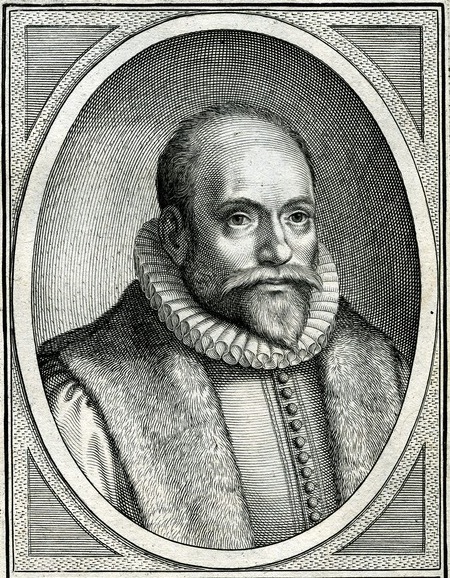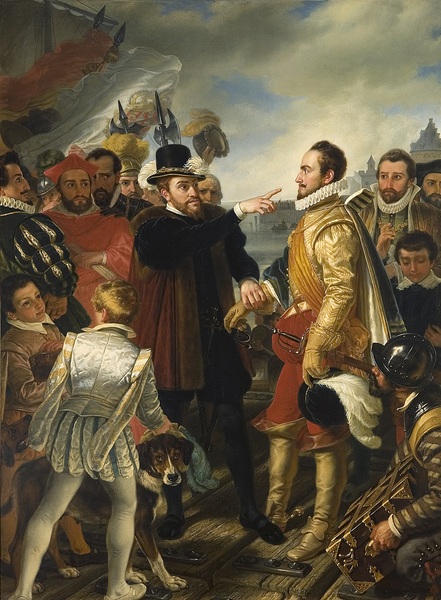|
Johan Van Oldenbarneveldt
Johan van Oldenbarnevelt (; 14 September 1547 – 13 May 1619), Heer van Berkel en Rodenrijs (1600), Gunterstein (1611) and Bakkum (1613), was a Dutch statesman and revolutionary who played an important role in the Dutch struggle for independence from Spain. He is generally considered as one of the greatest and most important political figures in the history of The Netherlands. Van Oldenbarnevelt was born in Amersfoort. He studied law at the universities of Leuven, Bourges, Heidelberg, and Padua, and traveled in France and Italy before settling permanently in The Hague. He favored William the Silent in his revolt against Philip II of Spain, and fought in William's army. In his later years he was a supporter of the Arminians during the religious-political controversy which split the young Dutch Republic. He was the founder of the Dutch East India Company. Early political life Van Oldenbarnevelt served as a volunteer for the relief of Haarlem (1573) and again at Leiden (15 ... [...More Info...] [...Related Items...] OR: [Wikipedia] [Google] [Baidu] |
Bakkum
Bakkum is a village in the Dutch province of North Holland. It is a part of the municipality of Castricum and lies about 12 km southwest of Alkmaar. It has three satellites: the village of , the hamlet and Bakkum aan Zee which is nowadays called . The village was first mentioned in the late-11th century as Bachem, and means "settlement on a height". Bakkum used to be a ''heerlijkheid''. In 1749, it was sold to Nicolaas Geelvinck who was Lord of Castricum among others. In 1812, Bakkum became a part of the municipality of Castricum Castricum () is a municipality and a town in the province of North Holland in the Netherlands. Castricum is a seaside town in the province of North Holland. It attracts tourists who come mainly to visit the beach and nearby dune landscape. Lake .... Some tourism developed in the early 20th century, but Bakkum never developed into a seaside resort town. After World War II, it started to form a single urban area with Castricum. Gallery File: ... [...More Info...] [...Related Items...] OR: [Wikipedia] [Google] [Baidu] |
Leiden
Leiden ( ; ; in English language, English and Archaism, archaic Dutch language, Dutch also Leyden) is a List of cities in the Netherlands by province, city and List of municipalities of the Netherlands, municipality in the Provinces of the Netherlands, province of South Holland, Netherlands. The municipality of Leiden has a population of 127,046 (31 January 2023), but the city forms one densely connected agglomeration with its suburbs Oegstgeest, Leiderdorp, Voorschoten and Zoeterwoude with 215,602 inhabitants. The Statistics Netherlands, Netherlands Central Bureau of Statistics (CBS) further includes Katwijk in the agglomeration which makes the total population of the Leiden urban agglomeration 282,207 and in the larger Leiden urban area also Teylingen, Noordwijk, and Noordwijkerhout are included with in total 365,913 inhabitants. Leiden is located on the Oude Rijn (Utrecht and South Holland), Oude Rijn, at a distance of some from The Hague to its south and some from Amsterdam ... [...More Info...] [...Related Items...] OR: [Wikipedia] [Google] [Baidu] |
Haarlem
Haarlem (; predecessor of ''Harlem'' in English language, English) is a List of cities in the Netherlands by province, city and Municipalities of the Netherlands, municipality in the Netherlands. It is the capital of the Provinces of the Netherlands, province of North Holland. Haarlem is situated at the northern edge of the Randstad, one of the Largest European cities and metropolitan areas, more populated metropolitan areas in Europe; it is also part of the Amsterdam metropolitan area. Haarlem had a population of in . Haarlem was granted city status or in 1245, although the first city walls were not built until 1270. The modern city encompasses the former municipality of Schoten, Netherlands, Schoten as well as parts that previously belonged to Bloemendaal and Heemstede. Apart from the city, the municipality of Haarlem also includes the western part of the village of Spaarndam. Newer sections of Spaarndam lie within the neighbouring municipality of Haarlemmermeer. Geography ... [...More Info...] [...Related Items...] OR: [Wikipedia] [Google] [Baidu] |
Dutch East India Company
The United East India Company ( ; VOC ), commonly known as the Dutch East India Company, was a chartered company, chartered trading company and one of the first joint-stock companies in the world. Established on 20 March 1602 by the States General of the Netherlands amalgamating Voorcompagnie, existing companies, it was granted a 21-year monopoly to carry out trade activities in Asia. Shares in the company could be purchased by any citizen of the Dutch Republic and subsequently bought and sold in open-air secondary markets (one of which became the Amsterdam Stock Exchange). The company possessed quasi-governmental powers, including the ability to wage war, imprison and execute convicts, negotiate treaties, strike Coinage of the Dutch East India Company, its own coins, and establish colonies. Also, because it traded across multiple colonies and countries from both the East and the West, the VOC is sometimes considered to have been the world's first multinational corporation. St ... [...More Info...] [...Related Items...] OR: [Wikipedia] [Google] [Baidu] |
Dutch Republic
The United Provinces of the Netherlands, commonly referred to in historiography as the Dutch Republic, was a confederation that existed from 1579 until the Batavian Revolution in 1795. It was a predecessor state of the present-day Netherlands and the first independent Dutch people, Dutch nation state. The republic was established after seven Dutch provinces in the Spanish Netherlands Dutch Revolt, revolted against Spanish Empire, Spanish rule, forming a mutual alliance against Spain in 1579 (the Union of Utrecht) and declaring their independence in 1581 (the Act of Abjuration). The seven provinces it comprised were Lordship of Groningen, Groningen (present-day Groningen (province), Groningen), Lordship of Frisia, Frisia (present-day Friesland), Lordship of Overijssel, Overijssel (present-day Overijssel), Duchy of Guelders, Guelders (present-day Gelderland), lordship of Utrecht, Utrecht (present-day Utrecht (province), Utrecht), county of Holland, Holland (present-day North Holla ... [...More Info...] [...Related Items...] OR: [Wikipedia] [Google] [Baidu] |
Arminians
Arminianism is a movement of Protestantism initiated in the early 17th century, based on the theological ideas of the Dutch Reformed theologian Jacobus Arminius and his historic supporters known as Remonstrants. Dutch Arminianism was originally articulated in the '' Remonstrance'' (1610), a theological statement submitted to the States General of the Netherlands. This expressed an attempt to moderate the doctrines of Calvinism related to its interpretation of predestination. Classical Arminianism, to which Arminius is the main contributor, and Wesleyan Arminianism, to which John Wesley is the main contributor, are the two main schools of thought. Central Arminian beliefs are that God's prevenient grace, which prepares regeneration, is universal and that His grace, allowing regeneration and ongoing sanctification, is resistible. Many Christian denominations have been influenced by Arminian views, notably the Baptists in the 17th century, the Methodists in the 18th century, an ... [...More Info...] [...Related Items...] OR: [Wikipedia] [Google] [Baidu] |
Philip II Of Spain
Philip II (21 May 152713 September 1598), sometimes known in Spain as Philip the Prudent (), was King of Spain from 1556, King of Portugal from 1580, and King of Naples and List of Sicilian monarchs, Sicily from 1554 until his death in 1598. He was also ''jure uxoris'' King of England and List of Irish monarchs, Ireland from Wedding of Mary I of England and Philip of Spain, his marriage to Queen Mary I in 1554 until her death in 1558. Further, he was Duke of Milan from 1540. From 1555, he was Lord of the Seventeen Provinces of the Habsburg Netherlands, Netherlands. The son of Emperor Charles V and Isabella of Portugal, Holy Roman Empress, Isabella of Portugal, Philip inherited his father's Spanish Empire in 1556, and succeeded to the Kingdom of Portugal, Portuguese throne in 1580 following a dynastic crisis. The Spanish conquests Spanish conquest of the Inca Empire, of the Inca Empire and of the Philippines, named in his honor by Ruy López de Villalobos, were completed during h ... [...More Info...] [...Related Items...] OR: [Wikipedia] [Google] [Baidu] |
William The Silent
William the Silent or William the Taciturn (; 24 April 153310 July 1584), more commonly known in the Netherlands as William of Orange (), was the leader of the Dutch revolt against the Spanish Habsburg Netherlands, Habsburgs that set off the Eighty Years' War (1568–1648) and resulted in the formal independence of the Dutch Republic, United Provinces in 1648. Born into the House of Nassau, he became Prince of Orange in 1544 and is thereby the founder of the House of Orange-Nassau, Orange-Nassau branch and the ancestor of the monarchy of the Netherlands. In the Netherlands, he is also known as Father of the Nation, Father of the Fatherland (; ). A wealthy nobleman, William originally served the Habsburgs as a member of the court of Margaret of Parma, governor of the Spanish Netherlands. Unhappy with the centralisation of political power away from the local estates and with the Spanish persecution of Dutch Protestants, William joined the Dutch uprising and turned against his fo ... [...More Info...] [...Related Items...] OR: [Wikipedia] [Google] [Baidu] |
History Of Early Modern Italy
The history of early modern Italy roughly corresponds to the period from the Renaissance to the Congress of Vienna in 1814. The following period was characterized by political and social unrest which then led to the unification of Italy, which culminated in 1861 with the proclamation of the Kingdom of Italy. Overview The Italian Renaissance covered the 15th and 16th centuries of Italian history and brought about considerable economic and cultural development of the country. After 1600, however, Italy experienced an economic decline. In 1600 Northern and Central Italy comprised one of the most advanced industrial areas of Europe. There was an exceptionally high standard of living. By 1814 Italy was an economically backward and depressed area; its industrial structure had almost collapsed, its population was too high for its resources, its economy had become primarily agricultural. Wars, political fractionalization, limited fiscal capacity and the shift of world trade to north-wes ... [...More Info...] [...Related Items...] OR: [Wikipedia] [Google] [Baidu] |
Kingdom Of France (1498-1791)
The Kingdom of France in the early modern period, from the French Renaissance, Renaissance () to the French Revolution, Revolution (1789–1804), was a monarchy ruled by the House of Bourbon (a Capetian dynasty, Capetian cadet branch). This corresponds to the so-called ''Ancien Régime'' ("old rule"). The territory of France during this period territorial evolution of France, increased until it included essentially the extent of the France, modern country, and it also included the territories of the French colonization of the Americas, first French colonial empire overseas. The period is dominated by the figure of the "Sun King", Louis XIV (his reign of 1643–1715 being one of the List of longest-reigning monarchs, longest in history), who managed to eliminate the remnants of medieval France, medieval feudalism and established a centralized government, centralized state under an absolute monarchy, absolute monarch, a system that would endure until the French Revolution and First ... [...More Info...] [...Related Items...] OR: [Wikipedia] [Google] [Baidu] |






